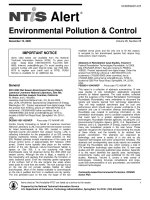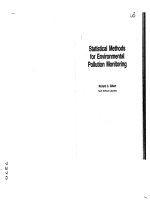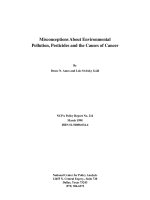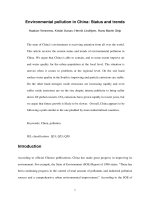Knowledge based expert system to minimise environmental pollution in Malaysian construction sites
Bạn đang xem bản rút gọn của tài liệu. Xem và tải ngay bản đầy đủ của tài liệu tại đây (196.19 KB, 10 trang )
I
NTERNATIONAL
J
OURNAL OF
E
NERGY AND
E
NVIRONMENT
Volume 2, Issue 2, 2011 pp.237-246
Journal homepage: www.IJEE.IEEFoundation.org
ISSN 2076-2895 (Print), ISSN 2076-2909 (Online) ©2011 International Energy & Environment Foundation. All rights reserved.
Knowledge based expert system to minimise environmental
pollution in Malaysian construction sites
Ibrahiem Abdul Razak Al-Hadu
1
, Lariyah Mohd Sidek
1
, Mohamad Nor Mohamad Desa
1
,
Noor Ezlin Ahmad Basri
2
1
Civil Engineering, Universiti Tenaga Nasional, Kajang, Selangor, Malaysia.
2
Civil and Structural Engineering, Universiti Kebangsaan Malaysia, Bangi, Selangor, Malaysia.
Abstract
Construction activities generate enormous amount of erosion and sediments sediments that is the result
of soil disturbance during construction activities, thus, will pollute the adjacent water bodies and make it
unfeasible for different uses. This paper aimed to develop and create the main features of an expert
system prototype (ESCES) for minimising erosion and sedimentation due to stormwater generated from
the construction activities by recommending a feasible BMPs. Multi criteria Analysis (MCA) technique
has been integrated so as to select the best control measure among many stormwater control alternatives.
A questionnaire has been distributed to the relevant experts so as to rank the stormwater control
measures to be used in the MCA technique. Using Visual Basic 6, Graphical User Interfaces (GUIs) were
developed. The knowledge and experience were acquired from various textural sources (i.e. guidelines,
manuals, literature, and human expert). Results from this study showed that the Best Management
Practices (BMPs) reommended have good suited the site characteristics. As a conclusion from this study,
the ESCES can be considered as part of the “Green Technology Tool” since it helps in protecting the
environment and preserve good quality of water adjacent to the construction sites in Malaysia.
Copyright © 2011 International Energy and Environment Foundation - All rights reserved.
Keywords: Best management practices, Construction sites, Environmental pollution, Expert systems,
Multi criteria analysis.
1. Introduction
People like living around water. This, joint with the omnipresent of surface water bodies all over the
nation, many times construction activities essentially occurred adjacent to water bodies. Construction is
not typically a source of conventional pollution such as chemical and biological contaminations, on the
other hand, for the reason that the large amount of land disturbed as a result of the construction activity,
construction sites are one of the largest contributors of sediment loading to our nation’s surface waters.
During construction phase, large areas of soil are exposed to the erosive forces either by wind or flow or
by both. This erosion may result in a significant increase in sediment loads to the receiving water thus,
will degrade the quality of the water. Construction site usually exposes large areas of bare soil to water
erosive forces, increasing the soil erosion rate to 2-40000 times to preconstruction levels [1] and results
in approximately 80 million tons per year of sediment supplied to US lakes, rivers and watersheds.
Before 1960, mining, agriculture, logging, and so forth, were the essential disturbances participating to
sedimentation to the adjacent water systems. Nevertheless, within the past two decades, construction
International Journal of Energy and Environment (IJEE), Volume 2, Issue 2, 2011, pp.237-246
ISSN 2076-2895 (Print), ISSN 2076-2909 (Online) ©2011 International Energy & Environment Foundation. All rights reserved.
238
activities have played an increasingly important role in this process and may currently equal to or exceed
all other sources [2]. Furthermore, harmful compounds may be involved in the runoff that has derived
from the construction sites. From past and recent studies, sediment indicated to overcome all other
pollutants in both quantities, total economic and ecological impact. In Malaysia, Kuala Lumpur and in
the neighboring urban centers of the Klang valley, urban development was particularly rapid in the late
1970s and 1980s. the rapid growth of urban development in Kuala Lumpur area has the effect of
excessive soil losses from construction sites and from sites cleared and awaiting development.
Construction sites in Malaysia usually involve bare eroding slopes and drains chocked with sediment.
Observation has been made and indicated that huge amount of this sediment transported from the
development sites. Areas subjected to construction usually experience sediment yields 2 to 3 folds of
magnitude greater than those under natural land cover conditions [3].
The sediments that results from the erosion process will result in a significant cumulative impact
downstream and over a longer time periods [1]. The sediments will cover stream bed and will
dramatically alter stream ecosystems, reduce light transmission, which limits in stream photosynthesis
and diminished aquatic food supply and habitat, nutrients associated with sediments contribute to the
development of algal blooms, erosion of stream banks associated with increased frequency and
magnitude of runoff events destroys riparian systems, and loss of topsoil from construction areas leaves
behind less fertile subsoil which hinders re vegetation of disturbed soil.
In addition to the environmental problems, there are significant direct economic impacts. Furthermore;
sedimentation may clog storm sewer systems, reduce reservoir storage capacity and hence increase flood
frequencies of receiving streams and rivers. All the above problems emphases on solutions to solve the
problems of onsite erosion and offsite sedimentations to the adjacent water bodies, these solutions can be
demonstrated by onsite and offsite best management practices (BMPs) for controlling the erosion and
sedimentation associated with the construction activities. The aim of this study is to develop a prototype
expert system which is entitled Erosion and Sediment Control Expert System (ESCES) for minimising
the erosion and sedimentation associated with the construction activities to the adjacent water bodies in
Malaysia and in other countries which have the same climate, environment, and topographic features.
Multi Criteria Analysis (MCA) technique is a structured framework for investigating, analyzing, and
resolving decision problems constrained by multi objectives .It is used to apprise a discrete number of
alternative options against a set of multiple criteria and conflicting objectives [4]. A key feature of MCA
is its emphasis on the judgements of the decision making team, in establishing objectives and. The MCA
is emerging as a popular approach for supporting multi stakeholder environmental decisions [5, 6]
describes a web-based multi criteria analysis which have been developed within the EU 5
th
Framework
DayWater project so as to support the decision making and solve the conflict between the stakeholder
and facilitate negotiation between them. [7] have utilized the multicriteria process for evaluating the
flood control options for the catchment of Livramento creek in Portugal. Recent research that applied the
MCA in water resources field involve reservoir operations [8]; planning or irrigation [9]; water quality
and ecosystem impacts [10, 11] evaluated three common alternatives, they are: sodding natural channel,
lined natural channel, and box culvert for the Malnichara channel in Bangladesh because this channel is
responsible for stormwater runoff conveyance to the downstream Surma rive. This river is found to be
encroached at many locations of the city and found to be very vulner vulnerable. The evaluation process
has been conducted by the application of the Multi Criteria Analysis (MCA) by adopting nine criteria
which have been categorised under four main criteria (Technical, Environmental, Economical, and
Social).
As mentioned earlier, the aim of this study is to minimise erosion and sedimentation due to stormwater in
Malaysian construction sites by adopting stormwater Best Management Practices (BMPs) that are
suitable to a specific site characteristics. Section 1 of this manuscript has provided an introduction and a
brief literature regarding the current study. Section 2 involved the methodology adopted during this study
accompanied with illustrative figures. Section 3 presented the results obtained from this study. Section 4
and 5 represent the overall evaluation of the ESCES and the conclusion respectively.
2. Methods
The methods adopted herein this research have been commenced from the data collection, interviewing
with the relevant experts, identifying whether this kind of problem is suitable for an expert system type
approach, knowledge acquisition, preparing the Graphical User Interface (GUI), and eventually
validation of the prototype. Figure 1 illustrates the overall methodology adopted in this study.
International Journal of Energy and Environment (IJEE), Volume 2, Issue 2, 2011, pp.237-246
ISSN 2076-2895 (Print), ISSN 2076-2909 (Online) ©2011 International Energy & Environment Foundation. All rights reserved.
239
Figure 1. Overall study methodology
2.1 The knowledge base
A knowledge engineer acquires knowledge from various sources of expertise and codifies it into an
expert system. The prerequisite for developing knowledge based system in the construction domain; the
knowledge engineer has to be familiar with the essential components of expert system technology as
wellas the domain of erosion and sediment control from construction sites in Malaysia, to develop a
successful system, it is also necessary to understand the language being used. In this approach, engineers
of the domain (the authors in this case) who have mastery of expert systems technology were to become
the knowledge engineers, have the experience in using the Visual Basic 6.
2.2 Flow diagram of acquired knowledge
After acquiring the knowledge from multiple expertise sources, a flow diagram for this rapid
prototyping, was developed as shown in Figure 2. This flow diagram was used to develop objects and
rules for the knowledge based. This diagram shown that the user have to check that the water quality
parameters before construction is hold, and then entitle these values as the base line water quality
parameters. Duration of need of the erosion and sediment control have to be selected either 0-6 months
or 6-12 months. The user has to select the erosion and sediment objective which will either be erosion
control, sediment control, or erosion and sediment control. For each of these objectives, have its own sub
categories. Site characteristics has to be inserted by the user so as to select the BMPs that are suitable to
the inserted site characteristics (e.g. drainage area extent, type of land use, soil erodibility, flow
condition, grade slope steepness and length, and so on). Now the system shall be able to give
recommendations that match the inserted site characteristics. Bu using the multi criteria analysis (MCA)
technique, the system shall be able to give the best alternative among many alternatives available to the
user by depending on some criteria for the evaluation whichever is best functioning in the reduction of
erosion and sediment generated from the construction sites. The MCA is both an approach and a set of
International Journal of Energy and Environment (IJEE), Volume 2, Issue 2, 2011, pp.237-246
ISSN 2076-2895 (Print), ISSN 2076-2909 (Online) ©2011 International Energy & Environment Foundation. All rights reserved.
240
techniques, aiming at providing an overall ordering of alternatives from the most preferred option to the
least preferred one [11]. It is used to appraise a discrete number of alternatives (options) against a set of
multiple criteria and conflicting objectives [12]. When the optimum solution been presented to the user,
the ESCES shall be able to provide the user with some information regarding the selected BMP like a
preliminary design, construction and maintenance, location by a simple guide, costing, and eventually
some graphics for further illustration of the proposed BMP. New GUI shall ask the user regarding the
water quality parameters during construction. Comparison between the measured water quality
parameters after installing the BMP and the existing values shall be fulfilled.
2.3Data collection
Data collection involve two types of data, , the first set of data is the primary data which can be collected
via questionnaire. The questionnaire has been collected from the relevant experts in whom the authors
have met them. The first aim of the questionnaire survey is to gather past and current information from
the relevant experts regarding experiences/problems related to stormwater erosion and sediment control
measures during construction activities in Malaysia, while the second aim is to get ranking for various
stormwater erosion and sediment control practices. The first meeting was conducted at the International
Hydrology Seminar which have been organised in Kuala Lumpur, Malaysia. In the seminar, the authors
have presented their project and the audience have ansked some questions for more clarification. The
audience was from different departments and organisations such as the Drainage and Irrigation
Department (DID), Department of Environment (DOE), and experts from other institutions (i.e.
academics) from the Universiti Kebangsaan Malaysia (UKM), Universiti Sains Malaysia (USM) and
other institutions and organisations. The second meeting have been conducted through a three days
workshop which have been organised and held in Universiti Tenaga Nasional, Kajang, Malaysia. The
questionnaire have been distributed to 50 participants and the authors have get the feed back from 10
participants only because some of the participants have not totally fill the questionnaire form and others
have commented that they are not so specialise in that field. Analysis from the questionnaire data can be
used as an input to the Multi Criteria Analysis (MCA) technique. The second set of data represents the
site investigation report data, environmental management plan data, and other reports for a specific
construction projects in Malaysia. The latter set of data can be used for validating the prototype expert
system ESCES.
2.4Multi criteria analysis structure
MCA technique can be used to find the optimum solution available among many other alternatives by
depending on some criteria and criteria weight. The criteria that are adopted in this study were clarified
in Figure 3. The questionnaire involved ranking of stormwater best management practices according to
the set criteria in Figure 3 below.
This paper have adopts and extended the basic structured classificatory methodology by Voogd (1983) to
the evaluation and selection of stormwater erosion and sediment control measures. There are many
methods used to standardisation of the ranked values collected from the experts. The most common one
is to adjust criterion scores based on their distance to a maximum and or/minimum value. For example
the top performing alternative for a given criterion is given a score of 1 and the worst performing
alternative is given a score of 0. The following approach to standardisation has been adopted in this
study:
minmax
min
jj
jij
ij
xx
xx
s
−
−
=
(1)
minmax
max
jj
ijj
ij
xx
xx
s
−
−
=
(2)
International Journal of Energy and Environment (IJEE), Volume 2, Issue 2, 2011, pp.237-246
ISSN 2076-2895 (Print), ISSN 2076-2909 (Online) ©2011 International Energy & Environment Foundation. All rights reserved.
241
where s
ij
= the standardized performance measure for x
ij
, x
ij
= the performance of the i
th
alternative
against the j
th
criterion in real units of any ty, x
j
max = the maximum performance score under the j
th
criterion, x
i
min = the minimum performance score under the j
th
criter.
Equation (1) can be used where a higher criterion score indicates better performance while equation (2)
can be used where a lower criterion score indicates better performance.
For ranking of alternatives (options), a great many techniques exit to obtain a ranking of alternatives
once the weights and performance measures have been entered into the MCA matrix. The techniques
primarily differ in how they handle qualitative and quantitative data, and decision maker preferences.
One of the most widely applied and most easily understood techniques is weighted summation. Using
weighting summation, the performance measures are multiplied by the weights, and then summed for
each option to obtain performance score. This is the approach taken here. The overall performance score
can be calculated by:
∑
=
=
m
j
jiji
wsv
1
.
(3)
where v
i
is t
he value (or utility) of the i
th
alternative relative to the other alternatives, S
ij
is the
standardized value of x
ij
(the performance measure for the i
th
alternative against the j
th
criterion),
w
j
= the weight of the j
th
criterion
2.5 Prototype development tool
For the development of the Erosion and Sediment Control Expert System (ESCES), object-oriented
software called Visual Basic 6.0 (VB6) was used. Apart from its powerful object oriented capabilities,
enable the interfacing with user, making human computer interaction more natural and easily, VB6 also
allows representation of knowledge using production rules. VB6
( is a very powerful
and safe programming language tools, further it is especially well suited for dealing with complex
knowledge. Moreover, VB6 was chosen because it’s proven reliability and knowledge engineers’
familiarity of working with this language.
2.6 Production rules of the acquired knowledge
Knowledge acquisition is the transfer and transformation of knowledge from some knowledge source to
an expert system program. Potential sources of knowledge include human experts, manuals, guidelines,
reports, and one’s own experience. The information included in this rapid prototyping expert system
ESCES knowledge based are acquired from many sources that were written by experts and related
professional institutions (Construction Site Best Management Practices (BMPs) Manual 2003,
Guidelines for Prevention and Control of Soil erosion and Siltation in Malaysia 2008, Urban Storm
Water Management Manual for Malaysia 2000, Guidelines for Prevention and Control of Soil Erosion
and Siltation in Malaysia 1996, Levi et al. 2004). Acquiring knowledge from such sources was felt to be
the most difficult and time consuming task in this rapid prototyping ESCES.
The knowledge acquisition was performed by classifying and summarising information needed
for the erosion and sediment control in construction sites and by incorporating the authors
experience in this field. Knowledge representation is a method of organising and representing
the knowledge. By far the most popular knowledge representation technique is ruled based. It
uses an if-then statement to represent a production rule.
The operation of the ESCES consists of a series of selections linked by if-then logic. Its control
system supports a forward-chaining procedure. This rapid prototyping runs on typical personal
computer configuration, requiring a run-time version of VB6 (for windows XP and above).









